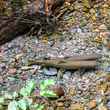Prior to Snowmaggedon here in the South, the drive into town had turned into an obstacle course. I’d jerk the steering wheel this way or that to avoid some hapless, already flattened critter, or a live one doing its level best to avoid that grisly fate. Roadkill typically peaks at this time of year as warming temperatures tempt hibernating and semi-hibernating animals out of their dens and puts them on the move for various reasons. What I’ve noticed on the road more than anything else are dead skunks, and dead skunks don’t lie. Dead skunks are the modern and tragic harbingers of spring.
We’ve got striped skunks (Mephitis mephitis) around here. They aren’t true hibernators but do spend extended periods cozied up in dens during cold weather, but they get outside the den often during the winter. What sets February and early March apart as prime skunk-movement time is their libido. We’re in the skunk “pre-rut” phase. While the recent arctic temperatures and deep snow paused the carnal festivities, those hormones keep flowing and the skunks are already back on their lusty quests.
But only male skunks are ramblers. Females typically have a home range of a half-mile up to two miles, and once they find suitable habitat they tend to homestead throughout their years. Male skunks, on the other hand, will search far and wide for a willing partner every late winter. They can travel up to five miles in a single night whilst looking for love, and they often look for it in all the wrong places—like in the middle of a two-lane highway.
We all know that skunks are equipped with some potent chemical weaponry, and this weaponry has proven effective on almost every type of natural predator that would try to maim a skunk. But a few oily squirts ain’t worth a damn against an F-150 closing in at 60-miles an hour.
Since skunks have relied on their noxious, yellowish-green miasma for protection since, well, since skunks came into being, they don’t have much in the way of athletic skills. It adds up to a recipe for road-kill carnage on a grand scale.
After the drama that accompanies breeding season, there’s seven to 10 weeks of gestation then mama skunks typically have four to six kittens, or kits, per litter. The little stinkers are equipped with scent glands from the get-go, but in my personal experience — which is hands-on and more extensive than it should be for a rational person — young skunks won’t spray unless very agitated. Kits will hang around with mom all summer long learning the nuances of what it means to be a skunk. Around September, they leave and look for territory of their own, thus beginning the second period of high skunk mortality on our highways.
Skunks are omnivorous, which means they eat anything they can find. Their diet includes small animals like mice, frogs, crayfish, insects, lizards, birds, and bird eggs. They also eat various fruits, table scraps, and any pet food that Fido or Kitty leave on the back porch.
Not many predators can get past the reek in order to enjoy a meal of skunk. Their top killers are birds of prey, particularly great horned owls. Since most birds have a weak sense of smell, they’re immune to the stench, rendering the slow-moving skunk an easy target when an owl or hawk gets a bead on them.
Once a skunk empties its scent glands, it can take seven to ten days for the glands to fill up again and during this time the skunk is effectively out of ammo and defenseless. Because of this, skunks don’t want to spray unless they absolutely must. Stink is used as a last resort, and skunks give all kinds of warning before they point the barrel and pull the trigger. If you get sprayed, it’s probably your own fault.
I know that it’s always been mine.
































Comments